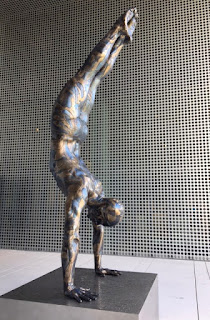 |
| Plensa's "Laura with Bun" |
I love a good artistic surprise. I got so excited when I saw the Jaume Plensa sculpture outside the Tampa Museum of Art that I nearly broke into a run (well, jog). And here I'd thought our visit was just a way to kill some time before dropping Maggie at the airport.
When I asked about the sculpture at the admission desk, I learned that I missed Plensa's "Human Landscape" exhibit at the Museum. How could that have happened? Plensa's work is right up my alley. The Spanish artist's sculptures are made of a variety of materials -- steel, cast iron, resin, light, sound -- and are intended to "lend physical weight and volume to multiple components of the human condition and soul."
The good news is that the Museum purchased Plensa's "Laura with Bun" so it is permanently on display. Click here to see more of his striking work.
 |
| Feurman's "The Golden Mean" |
I was a bit surprised by how different "The Golden Mean" is from her hyperrealistic work. But the theme of the connection between humans and water is the same. It's a concept Feurman has been exploring since the 1970s. "My subjects are swimmers. My medium is water," Feurman once remarked.
In this sculpture, she captures the moment before a high diver springs off his platform. (I wanted Maggie to replicate the pose for a photo opp, but she refused.) In Greek philosophy, the golden mean is the middle between two extremes. It's a place of symmetry, proportion and harmony. Feurman's sculpture captures this delicate balance.
 |
| Oliva's "The Great Journey" |
The Museum's Complicated Beauty: Contemporary Cuban Art exhibit also yielded some surprises. The description on the website had not enticed me. But the exhibit itself is filled with thought-provoking and clever works.
Pedro Pablo Oliva's "The Great Journey" depicts Cuban refugees traveling in an umbrella to get to sanctuary. Although his work has elements of humor, the intention behind it is deadly serious.
The danger associated with open waters for refugees was highlighted by Yoan Capote's "Isla (Umbral)," a work situated just around the corner from "The Great Journey." The piece is a canvas filled with black fishing hooks and nails. Maggie noted the different perspective of Americans about oceans.To us, they symbolize vacations and relaxation. But to others, they represent the perils of trying to reach a better way of life. (Click here to see a different work by Capote in seascape series along with his explanation of the series, in which he draws a comparison between the sea and the Iron Curtain.)
 |
| Poblet's "Simplemente Bellas" |
The idea for Poblet's work came from a visit to a Cuban women's prison where the inmates made plastic flowers from recycled materials. Poblet incorporates hundreds of these plastic flowers into her work, which explores "notions of aesthetics, identity and freedom."
I came away from our visit to the Museum with a continuing appreciation for the creativity of artists and the way they use their work to provide commentary on today's world. It's an increasingly important endeavor at a time when our government is silencing those within it whose views--borne out by research rather than alternative facts--differ from the party line.



No comments:
Post a Comment